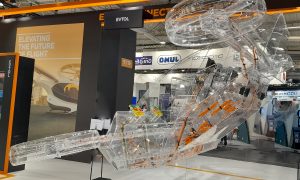
Martin Cullen is senior Business Development Manager at the aerospace, defence and marine unit of TE Connectivity, a US/Swiss technology company that designs and manufactures connectors and sensors for aerospace and other industries, including advanced air mobility platforms
Designing the electrical architecture for an eVTOL is a very different challenge to that of a conventional helicopter.
Yes. Helicopters are very well known for the “Jesus bolt”; they have quite a few single-points-of-failure. Electrical distributed architecture in an eVTOL provides an immediate inherent safety benefit. So having 612 motors and 16 rotors is very reassuring as a passenger. A lot of the public ask whether eVTOLs are safe, because they’re new, and I want to reassure them that fundamentally they have a much greater potential to be safer because there’s so much redundancy built-in. They have multiple power packs, multiple fuel sources and multiple energy sources. They are also a lot less complex. A gas turbine engine has around 4,500 components but in an eVTOL you can reduce that to 10, 50, 100.
Many helicopter engineers I speak to get quite angry about how fast eVTOLs are being certified, compared to the hugely complex and lengthy process for conventional helicopter certification.
It’s a new world. Digital engineering, cheap money and an untouched market of billions out there. There’s no carbon dioxide emissions or noise emissions at source, plenty of benefits and few of the nuisances that are associated with helicopters. I think there’s a great will to make this happen and I think a lot of people are hoping this will be a great stepping stone to net zero. It is all part of the learning curve – as we increase complexity of the system-of-systems as we move towards a larger passenger aircraft context there will be greater safety implementation and greater technical challenges to flying 5,000 to-6,000 miles across the Atlantic on electrical power sources. But there’s a lot of will to make this happen.
How do you engage with the regulators?
There’s two parts to this. A lot of start-ups come from automotive sector – they’re drawing in engineers from Tesla and BMW and they start to design their aircraft like a car. Their development process follows the automotive development process. Others started off that way but then realised that they’re an aerospace company and went down the aerospace route.
Many of the startups wanted to use automotive components; they tried aerospace, went back to automotive and have now finally come back to aerospace again where they really need to be.
In terms of safety and regulations we don’t talk to the FAA or EASA directly, we sit on the SAE committees for electrical aircraft.
We have found these companies are very reluctant to share their experience, they consider everything to be their intellectual property. From where we sit, we see the whole picture and we know there’s very little difference between them and that they’re all using state-of-the-art automotive powered architecture structures. With battery packs there’s some difference but fundamentally because they’re in a race to fly first, they mainly use off-the-shelf components. We’ve developed some derivatives, and they see the benefits in using them. But we are a reactive consultancy so we can’t say “you must use our components”. We continually advise our customers to be aware that these are not flying cars, they are aircraft, subject to aircraft rules and regulations. All the smoke and flame issues you have in aerospace applies to these vehicles.
There are often decades of use and every single component we propose has been qualified for aerospace use so it has the right level of safety behind it. We can also help by showing how to route these systems in a safe way, install them appropriately and swap data interconnectivity from copper to fibreoptic.
So it’s going to be an interesting mix and when the first aircraft does get certified in Europe or the USA only then will we start to see how high the bar has been set on what is allowed or not.
I do think we’ll see a lot of infant mortality with these vehicles. You have 12, 14, 16 rotors and you have a very high vibration environment. There’s going to be harmonics, frequencies throughout the structure, that won’t show themselves in the 100-200 hours of testing. They’ll show themselves in the 1,000 to 3,000 hours of operation. After a year or so of constant use I wouldn’t be surprised if we start seeing a lot of unscheduled maintenance issues around some of the activity areas such as battery packs and how they’re installed. This won’t show themselves during the flight testing they’re doing now.
So in the second generation of aircraft I’d be surprised if we don’t see a switch of strategies by the first gen of developers. I can see some of the larger aerospace companies waiting to see how the market pans out before they join.
In the flight control system there are a lot of functions going through a single system. How vulnerable is that to a central point of failure?
We don’t have that level of overview of our customers’ system architecture but I do see a time where we’ll see some more prognostic health monitoring (PHM) introduced, certainly as we go into the second and third generation, where we’ll have tens of thousands of these aircraft flying around. At that stage 10 to the minus nine might not be good enough; it might have to be 10 to the minus 12.
I think we’re going to get to a point where each aircraft has its own digital twin and there is a PHM system monitoring every single bit of vibration or imbalance; there’s going to be a sensor there monitoring it. So these things are going to be flying sensors eventually.
TE’s Aerospace, Defence and Marine Paris Air Show eVTOL mock-up, showing the components made by the company
Do we now have standardised aircraft maintenance and operating procedures for all eVTOLs?
If you look at the configuration of the architecture, some companies have just the one battery pack. Volocopter’s are replaceable and that’s fundamental to how they operate. We see some aircraft with two or three different battery packs, with one in the fuselage and two or four in a wing. That can vary. We see airframers with different numbers and types of charging points with many now switching to the Megawatt charging standard.
There is a lack of conformity and I think it will be a person running out with a plug and plugging them in for the few years. And you’ll need a fast charger for the first 15 minutes. You will see the rotor blades being swapped but I don’t think it’s going to be as bad as in the automotive electric vehicle sector where there is a different system for each country. When you look at the battery packs, there’s a difference of opinion on what companies feel more comfortable doing.
How will battery technology change in the next 10 years?
I’ve seen quite a few announcements of step changes in different lithium technologies so I think they’re going to get better, but there’s also going to be quite fast-paced iteration of these vehicles where different battery technology gets inserted into the same airframe. How that affects the certification process I don’t know. Will we be able to type certify high voltage power units in the same way we certify gas turbos, airframes or rotors? So if you want to make a fundamental change to the battery pack system, how do you do that? What’s the level of re-certification you need? That’s still a major question to be answered.
How do you see scalability in terms of aircraft design evolving?
That’s a difficult question. These aircraft are relatively cheap – they’re in the single-digit millions – so I think in aviation terms they’re fairly disposable. I see the VoloCities as having a three- or four-year lifespan. SpaceX set a great example of what’s possible with a fast-learn, fast-implementation philosophy, making constant changes to get to what is a cost-effective product. Startups are going to be particularly effective at doing that.
So I think we’ll see firstly a fast iteration of where new eVTOLs are designed to fit market niches and a different aviation environment than traditional aerospace with its duopoly of Boeing and Airbus, where Boeings tend to be more cost-effective and Airbus tends to be more technological. We will have niche players in certain regions with certain use cases.
They will be regional – with SkyDrive becoming a Volocopter-like product for the Asian market – and airframe manufacturers such as Limosa, Archer, Joby and Textron all offering three-to-four-passenger types. I think that’s where we are going to see consolidation. Then you will have Horizon and Lilium offering a seven-seater fast jet – so I think there’s going to be at least half a dozen or so successful airframers and a stable market by early 2030s. That’s not including personal air vehicles.


